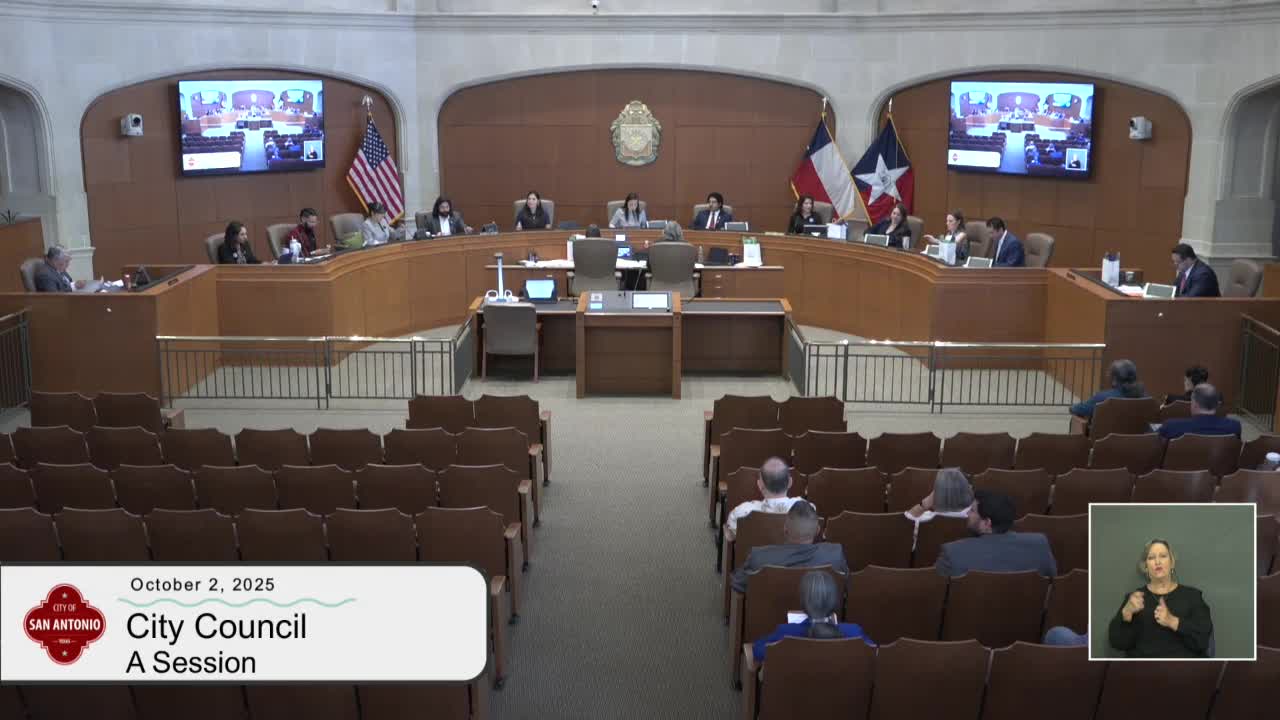Council adopts Goliad Road revitalization plan after amendment addressing street design and school safety
October 02, 2025 | San Antonio, Bexar County, Texas
This article was created by AI summarizing key points discussed. AI makes mistakes, so for full details and context, please refer to the video of the full meeting. Please report any errors so we can fix them. Report an error »

The San Antonio City Council on Oct. 2 adopted an ordinance approving a revitalization plan for an area along Goliad Road between Interstate 37 and Lerich Avenue, after amending the draft plan to remove a preferred street-design designation and to rename the design alternatives.
Councilmember Villagrán introduced the ordinance (agenda item 0.28) and described outreach that included bilingual surveys, two community open houses and work with local organizations and businesses. Villagrán proposed an amendment to “remove the designation of a preferred street design on page 7” of the plan and to relabel the listed alternatives (for example changing labels such as “preferred” and “alternative 1A/1B” into a set of numbered options) so the document’s language would align with the record.
Three members of the public spoke during the item. A resident, Andrew Yunosky, said neighbors oppose changing the corridor to three lanes and asked that four lanes be retained to avoid problems for buses and disabled riders. Georgie Hinojosa, president of the Highland Hills association, said the neighborhood supports revitalization and welcomed the planned improvements but noted growing traffic pressure in the area as nearby developments expand. Ana Alicia Romero, identified as a district external-affairs official, said schools are along the corridor and raised safety concerns about spillover congestion during student drop-off and pick-up; she said the district supports keeping the existing lanes in the school zone and urged coordination with city staff on routing and safe loading areas.
The council approved the amendment and then approved the ordinance as amended. The transcript records that the motion to amend passed and that the main motion passed after amendment; a detailed roll-call tally was not recorded in the available meeting text.
The ordinance covers a revitalization area described in the agenda as generally within 267 meters of Goliad Road from I‑37 south to Lerich Avenue; the council directed the city to adopt the plan as amended. The meeting record does not specify an ordinance number beyond the agenda item reference or list implementation deadlines or budget allocations tied to the plan in the public discussion recorded during the meeting.
Councilmember Villagrán introduced the ordinance (agenda item 0.28) and described outreach that included bilingual surveys, two community open houses and work with local organizations and businesses. Villagrán proposed an amendment to “remove the designation of a preferred street design on page 7” of the plan and to relabel the listed alternatives (for example changing labels such as “preferred” and “alternative 1A/1B” into a set of numbered options) so the document’s language would align with the record.
Three members of the public spoke during the item. A resident, Andrew Yunosky, said neighbors oppose changing the corridor to three lanes and asked that four lanes be retained to avoid problems for buses and disabled riders. Georgie Hinojosa, president of the Highland Hills association, said the neighborhood supports revitalization and welcomed the planned improvements but noted growing traffic pressure in the area as nearby developments expand. Ana Alicia Romero, identified as a district external-affairs official, said schools are along the corridor and raised safety concerns about spillover congestion during student drop-off and pick-up; she said the district supports keeping the existing lanes in the school zone and urged coordination with city staff on routing and safe loading areas.
The council approved the amendment and then approved the ordinance as amended. The transcript records that the motion to amend passed and that the main motion passed after amendment; a detailed roll-call tally was not recorded in the available meeting text.
The ordinance covers a revitalization area described in the agenda as generally within 267 meters of Goliad Road from I‑37 south to Lerich Avenue; the council directed the city to adopt the plan as amended. The meeting record does not specify an ordinance number beyond the agenda item reference or list implementation deadlines or budget allocations tied to the plan in the public discussion recorded during the meeting.
View full meeting
This article is based on a recent meeting—watch the full video and explore the complete transcript for deeper insights into the discussion.
View full meeting
